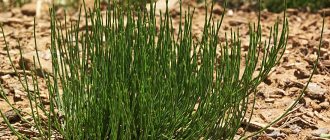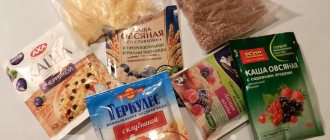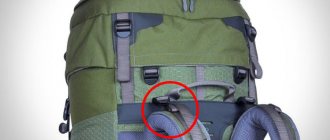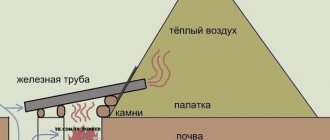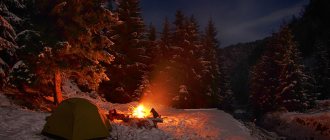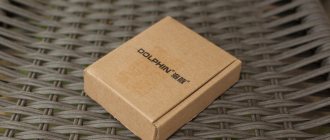Food on a hike
This is a separate chapter for beginners and professional tourists. In fact, “any food from the refrigerator” will definitely not work here. It is very important to figure out what kind of food is needed on a mountain hike, and what kind of food is better to forget about during the trip. Organizing meals on a hike is a whole science. The so-called layout, that is, the nutrition plan, is determined by such factors as the nature and location of the hike, its duration, the composition of the participants, and many others. Therefore, when planning a hike, it is important to correctly answer the question: what kind of food should you take on this particular hike . After all, the good mood of tourists and their general well-being depend on the correct diet.
As practice shows, the most optimal option is when all food issues on a hike are handled by one person - the supply manager. His responsibilities include drawing up a menu, counting and selecting the necessary products and distributing responsibilities associated with purchasing food for the trip. It is the caretaker who thinks about what food to take on a hike . When compiling a menu for food on a mountain hike , the caretaker must remember to set the calorie content and nutritional balance necessary for a person and, of course, to save space in the backpack and its weight. So, how to choose the ideal foods for a mountain hike in terms of calorie content? How to correctly create an approximate daily camping schedule per person? According to statistics, an ordinary man who leads a sedentary lifestyle spends about 2300 kcal per day, a woman - 1800 kcal. As you climb mountains, this figure will increase significantly. To each value you need to add 1000 kcal. At first glance, it seems that you can relax, grab cakes and soda with you... But! This does not work. Packing for a hike is the ability to take both useful and necessary items.
Food on a campfire
LiveInternetLiveInternet
gyord-pro-ladies
all posts by the author
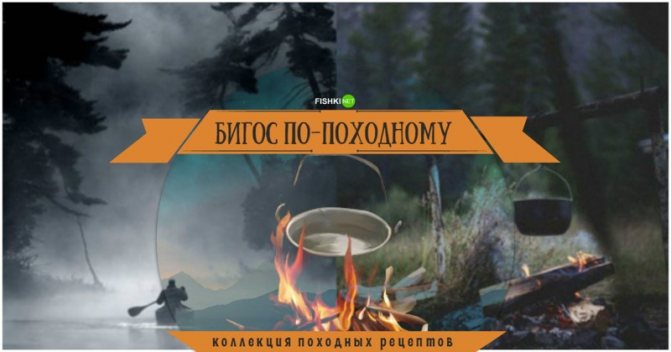
When hiking, all the food turns out surprisingly appetizing! We often remember the taste of this particular food and even try to recreate it at home. But alas, this is impossible! Because in camp food you can feel the taste of nature itself, in whose bosom everything is prepared. So gather your friends, put on your backpacks, read our recipes and go!
Traditionally, bigos is made from sauerkraut and meat, and the version of the dish that you will see below is slightly different from the original. Plus, the guys were lucky to shoot a duck on the hike, so they decided to smoke it in a camp smokehouse and add it to the stew. If you don’t shoot the duck, don’t despair, your bigos will turn out delicious without it! Now let’s find out all the secrets of preparing this delicious dish.
What you will need to prepare camping bigos:
- Stew (preferably beef) - 2 large jars of 500 g each; -Fresh cabbage - 500 g; -Tomatoes - 3 pcs.; -Bell peppers - 2 pcs.; - Hot pepper - 2 pcs.; -Onions - 3 pcs.; -Carrots - 1 pc.; -Apples - 3 pcs.; -Garlic - 1 head; -Raisins (seedless) - 70 g; - Salted parsley and dill prepared at home for the hike - 3 tbsp. spoons (can be replaced with dried parsley and dill); -Vegetable oil -50 gr.; -Black pepper - to taste, 4 bay leaves; -Salt - to taste;
So, let's attend
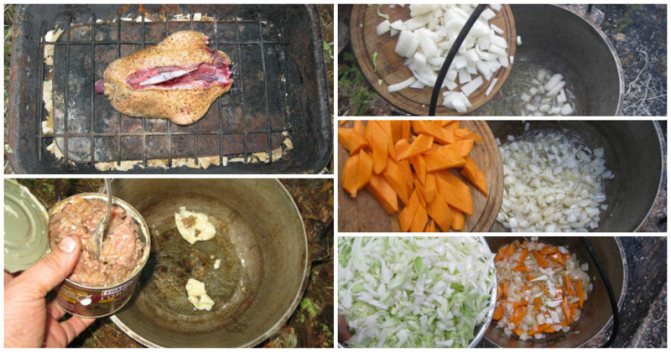
1. If you have a duck and a portable hot smoker, that’s a plus. A few words about how to smoke game. It is necessary to pluck, singe, gut and rinse freshly caught game with cold water. Next, sprinkle it with salt and pepper both outside and inside and leave for about 30 minutes. Place a couple of good handfuls of alder chips on the bottom of a clean, fire-burned and already cooled portable smokehouse (it can be replaced with bird cherry branches, which can usually always be found in the taiga). Place a special spreader for fat on top of the wood chips, then a grate, and finally, a wild duck carcass prepared for smoking, belly up. Close the smokehouse and leave the duck there for 40 minutes on well-heated coals. 2. Remove the fat from the stew (this is what the bigos will be cooked in). 3. Place the fat in a cauldron or cauldron, set it on fire, and as soon as the fat is well heated and boiling, add coarsely chopped onions to the cauldron (one onion head should be left). 4. When the onion becomes translucent (after 5-7 minutes), add sliced carrots to it. 5. After 7 minutes of frying the onions and carrots, shredded fresh white cabbage is sent into the cauldron.
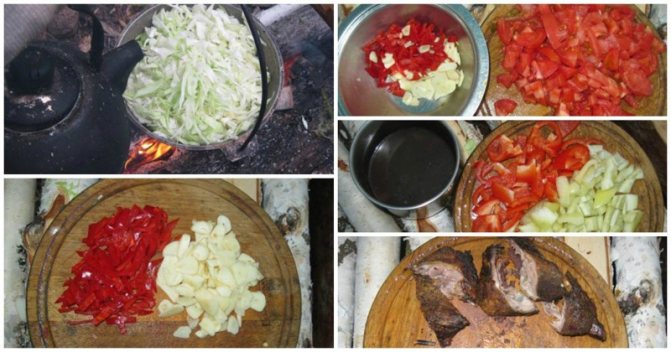
6. Then, pour about 150 milliliters of boiling water into the cauldron, after which you need to close it with a lid and simmer the vegetables at a moderate temperature for about 1 hour, and while the vegetables are stewing, prepare the remaining components. 7. Cut the garlic and hot pepper into thin slices and place them in a separate bowl. 8. Separately cut the tomatoes into small cubes. 9. Cut the bell peppers into small pieces and wash them, and then soak about half a mug of raisins in boiling water. 10. Cut the finished smoked duck into small pieces.

11. After which, fry the game with the remaining onion in a small amount of vegetable oil. We put the resulting frying aside for now. 12. Cut raw smoked sausage or any sausage at your disposal into small cubes. 13. After an hour of stewing the base of our bigos - cabbage, put the sausage into the cauldron, mix, simmer the vegetables with the sausage for about 10 minutes. 14. Next, two cans of stew are sent to the cauldron, 15. Then add fried onions and smoked game.
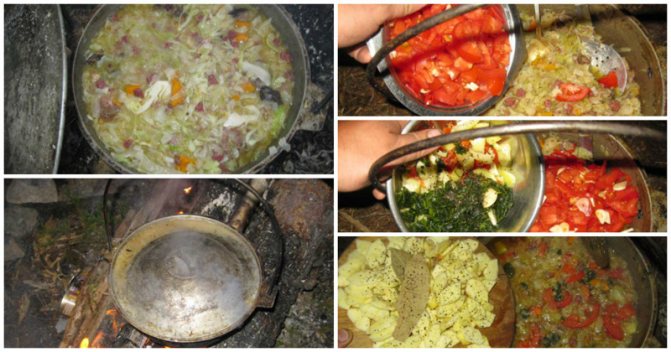
16. Mix everything thoroughly, after which the cauldron with bigos is closed with a lid and placed on moderate heat, where the dish is simmered for another 40 minutes. 17. Next, tomatoes with garlic and hot pepper are placed in the bigos. 18. Next, bell peppers with canned herbs. Now the bigos needs to be placed over the fire again, the contents of the cauldron simmered for about 15 minutes over moderate heat, after which sliced apples (which are previously peeled and cored), several bay leaves and black pepper to taste are placed in the cauldron.
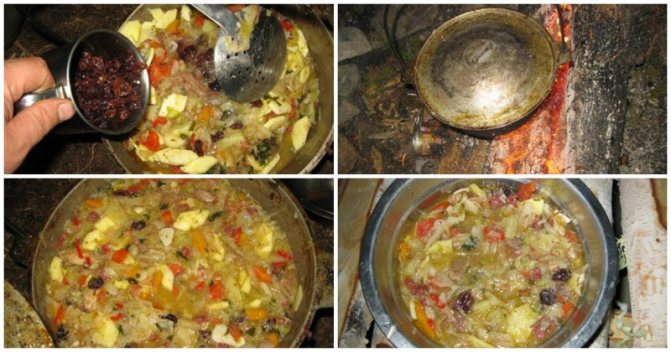
19. Next, soaked raisins are added to the bigos, and now it’s time to try what happened with salt (stew and sausage give a little salt), add salt to taste. 20. Stir again very well, simmer the bigos under a closed lid over very low heat (or better yet, over coals) for the last 30-40 minutes, and finally (if you haven’t been killed by hungry tourists by this time), serve the bigos to the camp spread the dish into bowls on the table. It is worth noting that this dish took about 4 hours to prepare, and real bigos is prepared 2 days before the intended meal. There is not that much time on a hike, but the guys were not at a loss and left the bigos on the coals to cook for another 5 hours. The result was excellent.
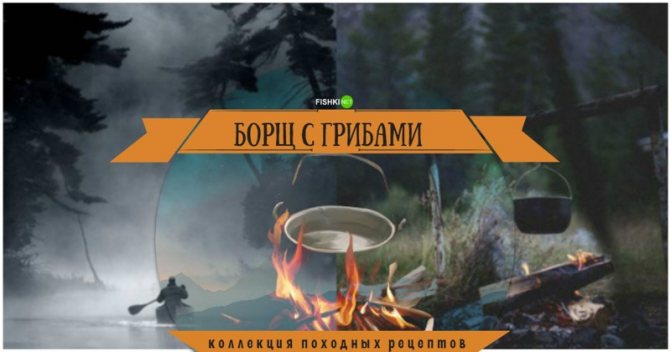
This borscht will perfectly satisfy your hunger during the day, and its taste is absolutely amazing!
What is needed to cook borscht with mushrooms and stew in a pot:
-For a 5 liter cauldron - stew - 1 large can (pork or beef) -Potatoes - 4 pcs. -Carrots - 1 pc. -Onions - 3 pcs. -Mushrooms (any mushrooms will do, for example: porcini mushrooms, boletus mushrooms, aspen mushrooms, chanterelle mushrooms) - 0.5 kg. -Tomatoes - 2 pcs. -Bell peppers - 3 pcs. - Cabbage - 1/4 fork - Garlic - 1/2 head - Ketchup - 2 tablespoons - Vegetable oil - for frying (can be replaced with fat from stew) - Dry dressings and seasonings for soup, special seasoning for borscht (contains granules beets), -suneli hops, black pepper - to taste -salt
Well, shall we feed the tourists some borscht?

1. Sort the mushrooms, peel, chop and soak for 15-20 minutes in slightly salted cold water, cut the onion into medium cubes. 2. Place a frying pan on the coals and pour a little vegetable oil into it (can be replaced with fat from the stew). Once the oil is hot, lightly fry the onion. 3. Then, pour the mushrooms into the frying pan (the salted water must be drained before doing this, and the mushrooms must be squeezed out), and fry the mushrooms and onions for about 15 minutes. 4. Remove the first roast for borscht from mushrooms and onions from the coals, add a little salt and pepper with black pepper. 5. Prepare the products for the second frying. Cut the remaining onions into medium cubes and cut the carrots into small cubes (if you have a grater on your camping trip, it’s better to use it). 6. Dump the fat from the can of stew into the frying pan (or use vegetable oil if you have it).
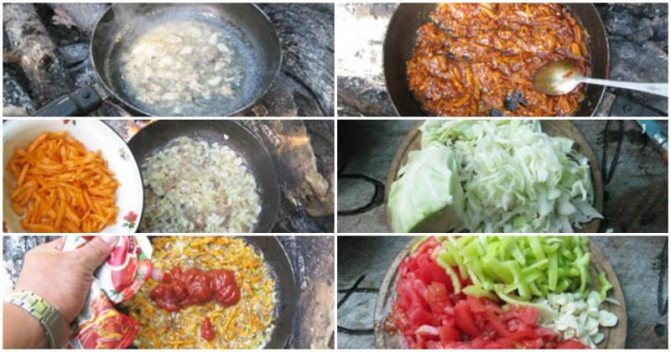
7. Melt the fat over coals and fry the onion on it until transparent, 8. Then add chopped carrots to the onion, 9. As soon as the carrots turn golden, add about two tablespoons of tomato ketchup to the frying. 10. Fry the vegetables with ketchup for another 10 minutes, avoiding burning. As soon as the second frying for borscht with mushrooms is ready, remove the frying pan from the heat, and it will be the best time to hang a cauldron with cold water over the fire... While the water in the cauldron is brought to a boil, we begin to prepare the vegetables for our borscht with mushrooms. 11. Shred the cabbage as thinly as possible. 12. Cut the tomatoes into small pieces, peel the bell peppers from seeds and cut them into half rings, also peel the garlic and cut into thin slices.
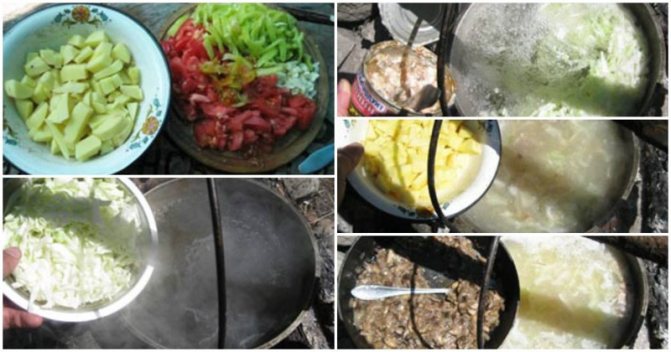
13. Peel and cut potatoes. 14. Pour cabbage into boiling water. 15. Then, add the stew to the borscht, let the cabbage and meat simmer for 10 minutes. 16. Pour potatoes into the cauldron. 17. Next, after 5 minutes, dump the first mushroom fry into the cauldron with borscht.
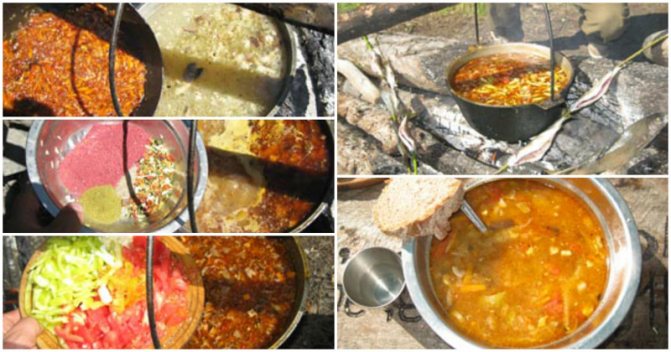
18. After another 5 minutes, after the borscht boils, add the fried onions and carrots into the soup. 19. Next, while the soup is cooking, prepare dry seasonings for soup, seasoning for borscht, hops-suneli, salt, pepper, etc. in a separate plate, after which we pour the contents of the plate into the borscht and mix everything thoroughly, 20. Another 5 minutes after adding dry spices to the borscht with mushrooms, pour tomatoes, garlic, and bell peppers into the soup, 21. Cook the borscht with mushrooms over moderate heat (so that it barely gurgles) for another 20-30 minutes, after which, call your friends and enjoy the taste .
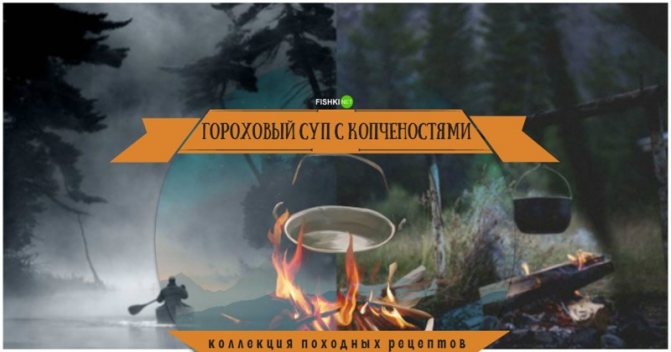
Everyone will definitely like the recipe for pea soup with smoked meats, especially if you get wet by unscheduled rain and need something to warm up.
What you need for a delicious smoked soup
-Water from a mountain stream - 4 liters. - Peas - 500 gr. - Beef (or pork) stew - 1-2 cans (depending on possibilities) - Raw smoked or any smoked sausage - 150 gr. - Potatoes - 2 pcs. - Onions - 1 pc. - Garlic - 5 cloves - A mixture of dried onions and carrots (if not available, replace with 1 more onion and 1 carrot) - Maggi-type broth cubes - 2 pcs. - Spices (any you like), bay leaf, black pepper, salt - Vegetable oil - 2-3 tablespoons for frying (can be replaced with fat from a can of stew)
So, let's prepare the soup

1. First you need to soak the peas. You can simply put it in a mountain stream for 20 minutes and it will wash itself, but you can devote 3 minutes to this activity and use your hand to stir the peas in ice water, constantly draining the water until the peas are thoroughly washed. Immediately a recommendation to the topic: if you are not on a working day, and you do not have an hour of free time to cook only peas for your soup, you can soak them in advance for 10-12 hours (for example, overnight) and then they will cook three times faster. 2. When the peas are washed, we go to make a fire and hang a cauldron of water over it, after which, without waiting for the water in the cauldron to boil, we pour the washed peas into the cauldron and immediately stir it. 3. While the peas are cooking (in total, this will take about 50-60 minutes), peel the vegetables. 4. As soon as the water begins to boil, foam will immediately begin to form in the boiler, which is highly advisable to remove immediately as it forms. 5. After about 15-20 minutes of boiling water, you can pour a mixture of dried onions and carrots into the cauldron; if there is no mixture, but just fresh carrots, then you can finely chop it and throw it in now or include it in the frying composition for a richer taste.

6. Frying is done as follows: place a frying pan or a boiler lid over the coals, and without waiting for it to heat up, put smoked sausage cut into small pieces on it (we need the fat to start rendering from the sausage), 7. Cut the onion into thin half rings, and pour it on top of the smoked sausage 8. While the fat from the sausage is rendering, you can open a can of stew and chop pieces of stew with a knife. 9. As soon as the sausage begins to grit slightly in its own fat, pour in a few tablespoons of vegetable oil (or fat from an open can of stew), and, stirring periodically and monitoring the intensity of the heat of the coals (to prevent burning), bring the frying to full readiness. 10. While the frying is being prepared, cut the potatoes into small pieces and pour them into the cauldron. 11. As soon as the frying is cooked and the sausage and onions have a “fried look,” put them aside for a while.

12. About 5 minutes after putting the potatoes in the cauldron, we send the stew there too, 13. Next - a couple of bouillon cubes, 14. After 10 minutes, the sausage and onion frying goes into the soup. At approximately this point, you need to check the soup for salt, and if necessary, add salt to taste. 15. Next, immediately add into the pea soup not very finely chopped cloves of garlic and a little black pepper, bay leaf and any spices that you like and that you took with you on the hike. 16. After adding the spices, let the soup simmer for 5 minutes, then remove it and let it brew for another 10-15 minutes. Fry the bread until golden brown and hurry up and pour yourself some soup before your fellow hikers gobble it up completely!
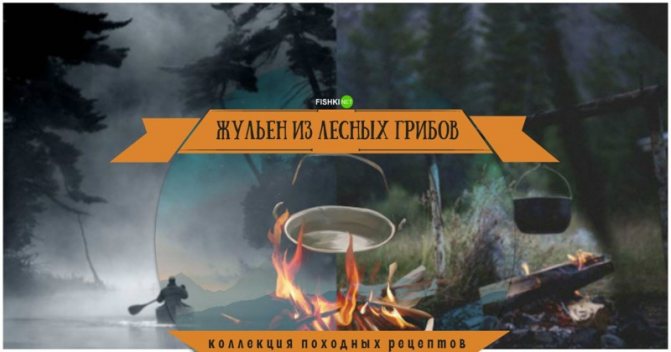
On almost any trip you manage to collect a certain amount of mushrooms, so add this recipe to your piggy bank and please your tourists with a delicious and aromatic julienne.
What you will need for julienne of wild mushrooms:
-Forest mushrooms - 300g. -Onions - 1 head; -Garlic - 5 cloves; - Powdered milk - 3 tbsp. spoons; -Mayonnaise - 2 tbsp. spoons; -Grated cheese - 4 tbsp. spoons - Vegetable oil - 5 tbsp. spoon; -Ground coriander - 1 teaspoon; -Dry dill - 1 teaspoon; - Ground black pepper - to taste; -Salt - to taste;
How to prepare it:
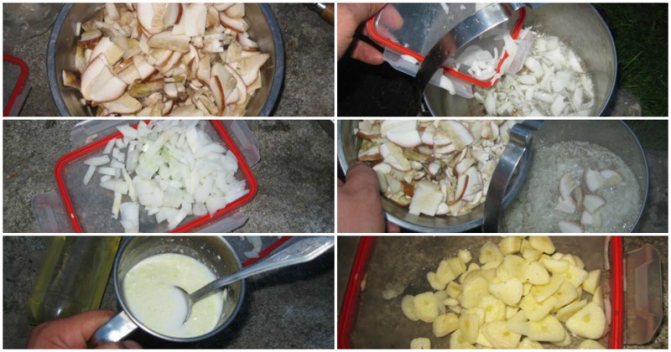
1. Clean the mushrooms and cut them either into julienne (thin strips) or into thin slices. 2. Onion - small cubes. 3. Dilute 3 tablespoons of powdered milk with warm water and mix thoroughly and break up the lumps - this will be the basis of the julienne sauce. 4. Place a saucepan on the primus stove, pour in a little vegetable oil, heat it well and quickly fry the onion until translucent. 5. Add the mushrooms to the onions, and stirring occasionally so as not to burn, fry the contents of the pan for 10.6 minutes. While the mushrooms and onions are frying, cut the garlic into thin slices or julienne.
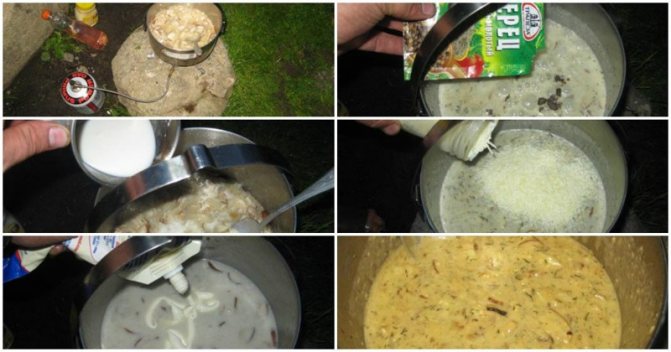
7. Mix the julienne well, and after 10-12 minutes of frying the mushrooms, pour the diluted dry milk into the pan, 8. As soon as the contents of the pan boil, add a little mayonnaise, then simmer the julienne over low heat for another 5 minutes, after which, add to the pan dry parsley, coriander and black pepper to taste. Let the appetizer simmer for another 2 minutes. 9. Sprinkle the dish liberally with grated cheese, mix everything well, check for salt (cheese and mayonnaise are salty!) and, if necessary, add salt to the julienne to taste, 10. Add garlic, mix, then simmer the julienne on low heat for another 3 minutes, after which the dish can be served at the camp table.
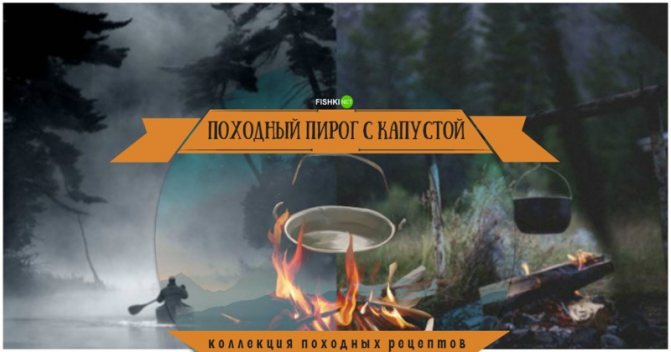
It happens that some food is left behind during a hike. In this case, cabbage and carrots were left over, as a result of which an amazing pie was prepared in a camp oven.
So, for the cabbage camp pie, let's take:
- Cabbage - 500 g; -Carrots - 1 pc.; - Onions - 2 medium heads; -Flour - 1 kg; -Yeast - 1 package; -Sugar - 1 tbsp. spoon; -Vegetable oil - 7 tbsp. spoon; - Ground black pepper - to taste; -Salt - to taste
Let's start cooking
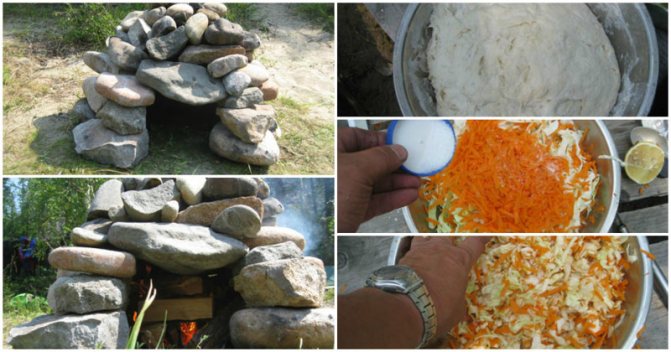
You can bake a pie in a smokehouse, burying it in the coals of a fire, or you can try to build such a stone wood-burning oven. 1. The oven needs to be heated well, so we light it, fill it with wood and go put the dough and prepare the filling for the pie. 2. The dough is easy to prepare. Dilute one heaped tablespoon of sugar with a glass of warm water, add a teaspoon of salt, dissolve everything well and pour out a package of quick-acting yeast, wait about 5 minutes. Next, pour a kilogram packet of flour into a deep bowl, make a well in the middle of the heap of flour, pour in Mix the resulting dough into it, add a little more water. Next, the dough needs to be covered and exposed to the sun so that it rises. In the meantime, you can start filling. 3. Finely chop the cabbage, grate the carrots on a coarse grater, put everything in a separate bowl, and sprinkle a little salt. 4. Mix the cabbage and carrots thoroughly with your hands so that the cabbage becomes soft. 5. After that, put a cauldron on the fire, pour a little vegetable oil into it, fry a couple of onions cut into small cubes in oil, add cabbage and carrots to the onions, fry a little with the onions. Now you need to add a little water, cover the cauldron with a lid and simmer our pie filling for 10-15 minutes over moderate heat until fully cooked. After preparing the filling, it is advisable to cool it a little, for which you can simply place the cauldron with cabbage for 10-15 minutes in a mountain stream or river!
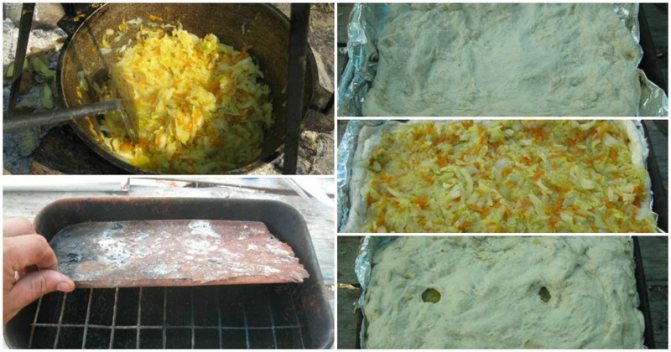
6. To slightly reduce the heat, the author of the recipe took his camp smokehouse, installed a grate, placed a tray on it to collect fat, covered it with two layers of usually aluminum foil, and on top of the foil, laid a layer of half the resulting dough. 7. Place the cabbage filling on top of the laid out dough, having previously separated all the excess liquid from the filling, cover the cabbage with a second layer of dough. 8. We carefully pinch all the edges of the pie, make one or two holes for steam to escape, then give our pie another 10 minutes for the dough to rise.

9. Bake the cabbage pie for 20-25 minutes, determine readiness by checking the dough by piercing it with a splinter. 10. Take the cake out of the oven and let it cool, after which we cut it into portions and treat it to everyone present.

What we need for a delicious pilaf on a hike:
For a 5 liter cauldron: -1.5 kg of meat; - 1 kg of onions and carrots; -800 grams of rice; - spices to taste; -2-3 heads of garlic.
Cooking aromatic pilaf in a cauldron
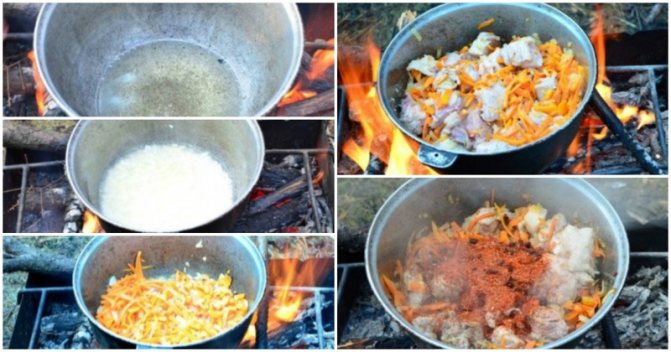
1. Pour oil into a hot cauldron and let it warm up. 2. Add onion. 3. When the onions are a little tired, add the carrots and mix. 4. When the onions and carrots are almost cooked, add the meat and mix. 5. Add spices. Better by weight and preferably with the addition of barberry and cumin!
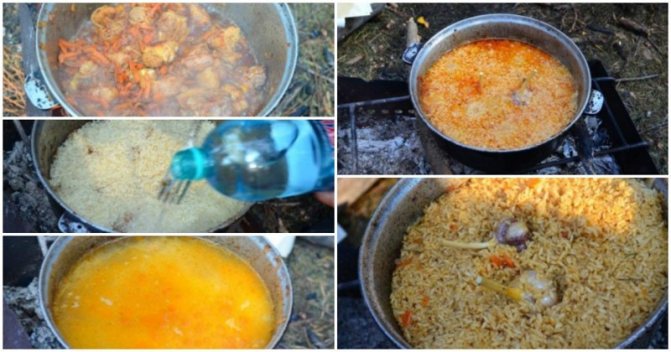
6. After the meat is cooked, add rice (steamed) in an even layer. 7. Fill with cold drinking water. 8. Pour water so that it covers the rice by 2 fingers... (the main thing is not to overfill the water) 9. Add salt and after the water has boiled away on the surface, add the heads of garlic. 10. Cover with a lid and forget for 40 minutes. Then you won’t be able to drag away hungry tourists by the ears! 

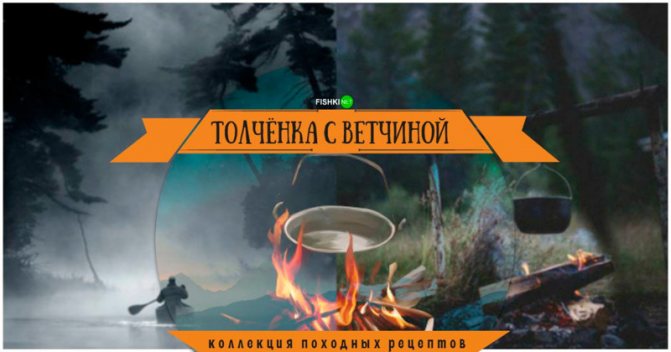
What is needed for pounding in field conditions?
-Semi-finished mashed potatoes - 1 package; -Ham - 1 can; - Powdered milk - 4 tbsp. spoons; -Onions - 1 head; -Garlic - 5 cloves; -Vegetable oil - 4 tbsp. spoons; - Ground black pepper - to taste; -Salt - to taste;
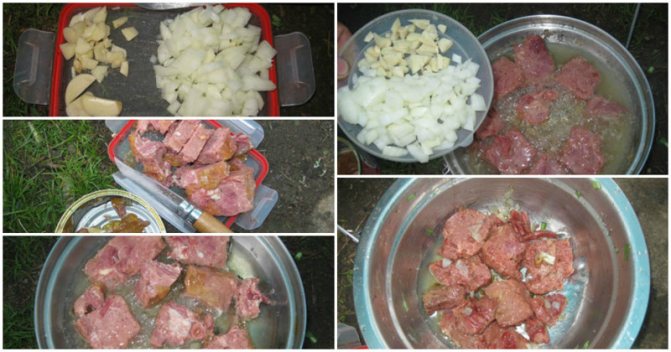
1. Cut the onion into small cubes. 2. Cut the garlic into pieces. 3. We take only the ham out of the jar (not all the contents), and, placing it on a board, cut it into small pieces. 4. Next, heat a small amount of vegetable oil in a frying pan and start frying those same chopped pieces of ham. 5. As soon as all the excess fat has been rendered from the ham, add chopped garlic and onion, add pepper, and fry for another 1 minute. 6. Carefully transfer all large and whole pieces of ham from the frying pan into a separate bowl.
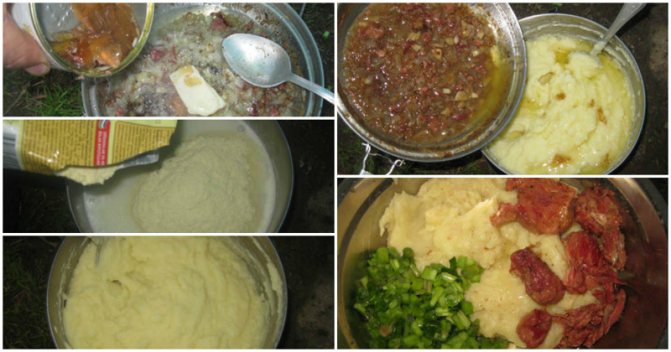
7. Place everything that is left in the jar into the frying pan and fry it all for 2 minutes! 8. Now you can prepare the puree. We dilute the powdered milk in a mug, and put 1/2 liter of water on the fire until it boils (for more precise proportions of water and milk, check the instructions for mashed potatoes). 9. When the water has boiled, pour in the diluted dry milk, and add the mashed potato powder while stirring constantly, at the same time beat the mashed potatoes with a spoon and add our frying from the frying pan to it. 10. Stir the frying mixture into the potatoes until smooth. If necessary, add salt to taste. Let's serve. The author uses dry potato concentrate, but you can also use regular potatoes - whoever has what! Of course, with regular potatoes you will get a dish that is both tastier and healthier than with concentrate, the only advantage of which is that you don’t have to carry bales of potatoes with you. 

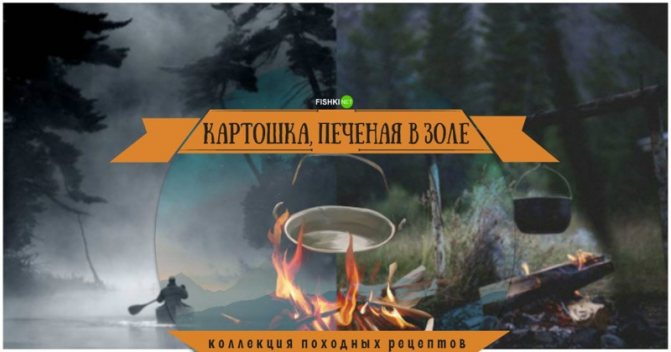
Probably one of the most favorite tourist recipes, the taste of which is familiar to everyone who has ever been on a hike!
What do you need for potatoes baked in ash?
Potatoes - as much as you like Bonfire with a pile of ash
Good old recipe

1. To cook potatoes you need a long-burning fire. Carefully move the fire to the side, and in the place where it was, use a spatula or stick to dig a hole in the ash. 2. Place pre-washed and clean potatoes (preferably dry) into the prepared hole. 3. We bury it with ash so that the layer of ash above the potatoes is at least 5-7 centimeters (otherwise the potatoes will burn during the casserole!) 4. In place of the potatoes just buried in the ash, we again build a larger fire and maintain it for 1 hour. 5. After the specified time, we dismantle the fire, and carefully raking the coals and ash, we take out our fully baked potatoes. Let's eat!
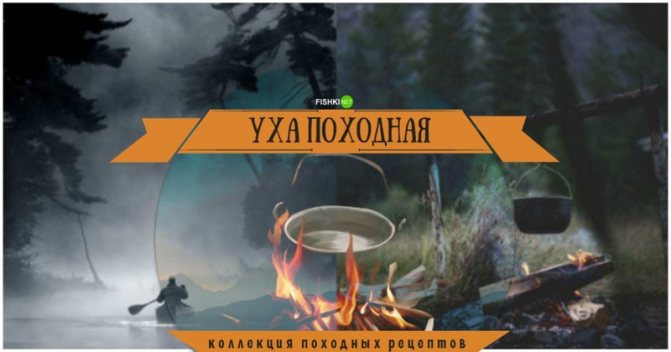
There are a great many recipes for successful fish soup and here is just one of them!
Some tips for cooking fish soup
1. It is best to take water from a reservoir, this will give the fish soup that unique taste. However, if the pond is polluted, it is better not to do this. 2. Do not cook crucian fish soup!!! The soup will be bitter and have an unpleasant smell and taste. If the pond is crucian carp, then soak the fish in salt for at least 30 minutes, or even better in water with vinegar. Also, do not cook fish soup from catfish and tench. 3. The fish soup is cooked only with the lid open! After cooking, remove the pot and only then cover it with a lid for a few minutes!
How to cook fish soup:
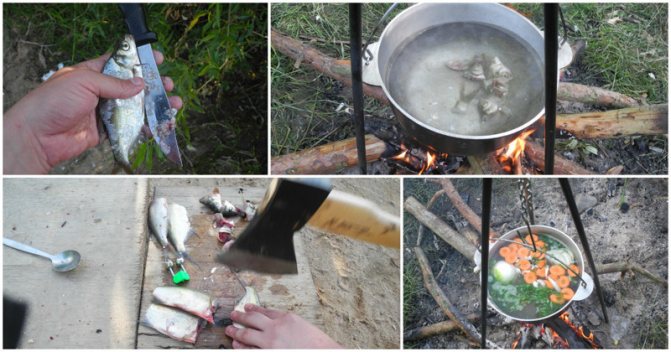
1. Take the fish, clean it from scales, gut it, remove the gills and eyes. 2. Throw the heads and tails into the boiling water of the cauldron and boil for 15-25 minutes (on a low simmer). 3. While the heads are boiling, we make fish fillets, which we will then cook and eat. 4. Prepare potatoes, carrots and onions. Many people boil potatoes and onions whole, but you can also cut them. A matter of taste! 5. Remove the fish heads and tails from the pot and throw in the carrots and potatoes (the potatoes can be thrown in a little earlier, because they take a little longer to cook). When the potatoes are almost half ready, add the onions and fish pieces that we will eat directly. 6. After 10 minutes, add herbs, salt, bay leaf. We also take a firebrand of coal (preferably birch) and, after shaking off the ash, throw it in the ear for a minute. It will draw out all third-party odors. 7. A few minutes before the end, add a little vodka. When added, it evaporates and the temperature of the fish soup increases. This helps the fish meat to be softer. After this, the soup is ready and can be safely eaten. The main thing is to cook at a low simmer; this largely determines the success of the fish soup.
Happy hiking everyone! And if you have your own delicious and proven recipe, tell us about it in the comments!
source
What food to take on a hike?
Firstly, foods should be rich in carbohydrates: simple (sugar, chocolate, cookies, raisins), which release sugar into the blood in a matter of seconds, and complex (oatmeal, buckwheat, grain bread), which, due to long-term breakdown, help dull the feeling of hunger . Many tourists prefer fast carbohydrates - they can be taken with them in large quantities due to their low weight. Secondly, we must not forget about proteins, which support the functioning of muscles and give them strength. However, you need to be careful here: if there is too much protein, the acidity in the blood increases. This means that it becomes more difficult to oxygenate the muscles. At the same time, protein from meat is not popular among mountain tourists, since meat is heavy and quickly spoils. Many tourists still carry canned meat with them, but this is not the best option, since the efficiency of such canned food is very low due to the weight of the packaging. On our hikes, we use high-tech canned food in retort packaging, which is much lighter than regular cans. An alternative option for obtaining protein is dried meat, raw smoked sausage, freeze-dried foods and legumes (peas, lentils, etc.) Thirdly, fats are necessary for the normal functioning of the body. It is recommended to choose unsaturated fats - nuts, seeds, etc., since animal fats are poorly absorbed during intense physical activity. Fourthly, every self-respecting hiker remembers the importance of vitamins, especially vitamin C. So, sweet tea with lemon is a good remedy for altitude sickness and an excellent way to get rid of the symptoms of an incipient cold. And of course, water is a classic “fuel” for the body. It helps maintain normal blood pressure, saturates with energy and quenches thirst. It is recommended to drink at least 1-2 liters per day. It is important not to forget about the need for a varied diet, since, along with satisfying the basic physiological needs of a person, food on a hike should also satisfy his psychological needs: the desire to eat varied and tasty food.
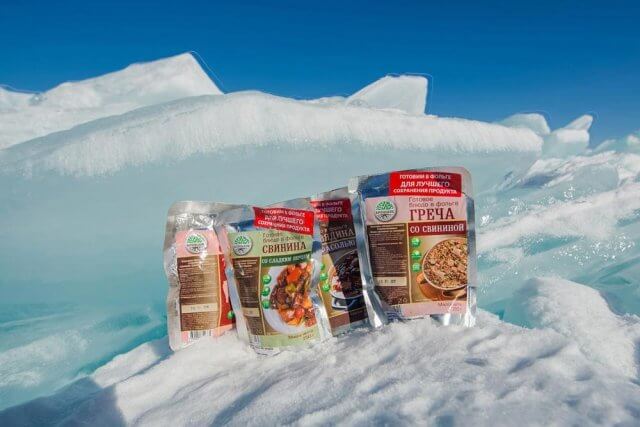
Food on the go: stew in soft retort packaging
General culinary rules
While traveling, all tourists cook food one by one (in order of duty).
Considering that some of them do not have the necessary cooking experience, let us recall a few general rules for cooking while camping. Potatoes should be boiled in salted water. The meat for the soup begins to be cooked in cold water, and only then vegetables, etc. are added.
The fish in the soup is boiled until cooked, and then removed so that it does not overcook.
Add a little salt to the water for porridge, and salt the peas, beans, and beans when they are boiled.
Before frying anything, the pan must first be heated.
Before cooking, millet cereals, rice, pearl barley and some other cereals need to be washed in several waters.
Salt is added to food to taste.
Approximately for a mug of cereal you need a secret spoon of salt. For milk and sweet cereals - half a spoon.
Cook the porridge over high heat (with stirring) until thickened, and then over low heat.
Canned meat should be placed in boiling suya immediately before removing it from the heat.
The fish is cleaned of scales by holding it by the tail and scraping it away from you with a knife, then gutted.
To easily remove scales from fish, immerse it in hot water for a minute.
Before frying, the fish is rubbed with salt and rolled in puka or breadcrumbs.
It is recommended to soak dry vegetables in water for 1-1.5 hours before cooking.
Before putting prunes in porridge (rice, millet, semolina), you must first soak them in boiling water.
To get rid of the bitter taste of millet porridge, pour boiling water over the washed millet, quickly bring the water to a boil and drain it. After this, cook the porridge.
To avoid sticking, vermicelli, noodles, and fluffy rice must be cooked strictly according to the clock, respectively, 8-10, 15-18 and 18-20 minutes. After cooking, rinse with cold water.
If you forgot to put salt in the thickened porridge, then you need to dilute it in boiling water and pour this solution into the porridge while stirring.
To cook rice, you can put it in cold water, bring it to a boil, and then, after draining the boiling water, add cold water again. By repeating this two or three times, you get a crumbly porridge.
To ensure that morning cooking takes a minimum of time, cereals (except semolina), peas, beans, and beans should be soaked in cold water in the evening.
Stale bread is wrapped in a damp cloth and then hung on a rod over the hot coals of a fire - it will become softer.
Frozen potatoes cannot be thawed by the fire: after washing (wiping them with snow) and without peeling, they are immediately immersed in boiling water.
Before hanging a bucket or pot over the fire, you need to rub it with a soapy sponge or just damp clay. It is easier to wash such dishes - the soot will come off along with soap or clay.
Horsetail or other vegetation can be successfully used as a washcloth for washing dishes in camping conditions, and you can wash your hands if you run out of soap using clay, elderberries, or simply coastal sand.
While at the fire, the person on duty must take the necessary precautions and be properly dressed and shod to avoid burns.
Cooking while camping
When planning meals on a hike, it is important to think about the process of preparing food. In most cases, food is cooked over a fire or burner. However, factors such as rain, lack of firewood nearby, a ban on making fires, for example, in nature reserves, a limited amount of gasoline or gas for the burner, make cooking problematic, so you need to calculate in advance the amount of gas, parking places and ignition for wet wood. Or include freeze-dried products in the menu that do not need to be cooked, but simply add hot water, which will save time and gas (firewood).
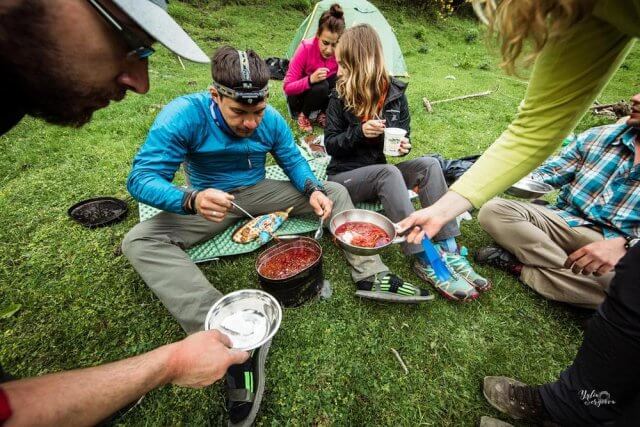
Food on the hike: freeze-dried borscht
Dishes for camping
Each participant in the hike should have a mug, spoon, bowl and knife. This is a universal formula that works on all journeys. As for boilers, it all depends on the number of people. In the old school of tourism, it is recommended to calculate this: 0.7 liters for each person. That is, if there are 6 people in a company, then a 4-liter boiler is needed. New technologies allow the use of integrated cooking systems (jetboil, MSR, fire-maple). Together with the use of sublimates, this allows you to take only one system with a liter pot for 5-6 people and much less gas (due to the cost-effectiveness of such systems), which ultimately has a very positive effect on the weight of group equipment.
Freeze-dried food for hiking
We have already mentioned freeze-dried foods several times. Let's figure out what it is. Many old-school tourists are skeptical about this format of food, saying that it’s not real, it’s unclear how they did it... etc. In fact, doubts are easy to dispel - you just need to understand the process of creating “unusual” food.
Sublimates are products from which water is removed by sublimation. First it is frozen, then dried in a vacuum. Note that most of the beneficial elements are retained, and there is no need to use preservatives. There is no big secret in the technology of preparing freeze-dried food. And mistrust arises solely out of ignorance. There is an opinion that freeze-dried food is not as healthy as regular food, which is purchased in grocery stores. But it has long been proven that sublimates retain more useful components than, for example, dried mushrooms or berries. Compared to the classic layout, freeze-dried food has a number of advantages. Freeze-dried foods weigh little, are quick to prepare, they are healthy, familiar and varied, you can easily calculate the portion and after eating them there is no need to wash the dishes. Conclusion: buying sublimates and adding them to your layout is a good and, most importantly, useful idea!
Harchi's daily sample camping schedule per person with freeze-dried food includes three meals a day and ensures that there is a hot dish at every meal: Breakfast: This is an energy boost for the whole day. It should be rich in complex carbohydrates to keep you comfortable until lunch. Option: freeze-dried porridge with fruit (oatmeal, banana, millet, chia pudding), coffee or tea, cheese sandwich, cookies, chocolate; Lunch: At lunch we deliberately avoid fast carbohydrates, as they can cause stomach discomfort. Option: freeze-dried soup (lentil, pea, borscht, etc.), bread or biscuits, cheese; Dinner: we must replenish all energy reserves spent during the day and restore the body’s strength. Option: freeze-dried second course (buckwheat and rice with meat, vegetables with meat, couscous with vegetables, pasta with meat and mushrooms, etc.), tea, cookies, chocolate; Between main meals, you can have short snacks with oat bars, dried fruits or candies. The main thing is not to overdo it and observe moderation in everything. This layout option allows you to reduce the weight of food on a hike to 300 grams per person per day, which is 3 times less than the usual layout. And also save time and effort on cooking. The diet needs to be adjusted depending on the wishes of the tourist. If you eat the same thing every day, there is a high probability that you will quickly get bored with food and cease to be enjoyable, so on our trips we use more than 20 options for freeze-dried dishes and high-tech canned food in retort packaging.
Cooking methods
Food processing makes most products more tasty, easily digestible, and destroys bacteria, poisons and other harmful substances contained in plant and animal foods.
Boiling (boiling). This is the best cooking method because the food is cooked in its natural juices. Any container that holds food and water can be used as a cooking vessel. For example, water can be boiled in a hole made in clay or in a hollow log by lowering hot stones into the water. Half a green coconut or a piece of bamboo, cut above or just above the joint, can be successfully used for boiling water, since such "ware" does not burn before the water reaches the boiling point. Birch bark and banana leaves are also good remedies for this. Their edges can be secured with thorns or splinters of wood. Water can be boiled in a scoop created in this way, covered on the outside with clay.
Extinguishing. This operation can be done in an oven set over even, moderate heat. This could be a pit under fire, a closed container or leaves, paper greased on the outside with clay. To extinguish food in a pit, you first need hot coals. Lower the closed container with water and food into the hole. Place a layer of coals around it, and cover it with a thin layer of soil on top. If possible, cover the hole with stones to better retain heat. Using this method prevents flies and other insects from getting into the food.
Steaming. This method does not require any weather and can be used when products do not require long cooking. Place the leaf-wrapped food on the burning coals in a stone-lined pit. Place a layer of soil on top of the leaves and around the pole. Take it out and pour water through the remaining hole. This is a slow but effective way of cooking.
Drying. This method may be preferable in some cases, particularly for grains and nuts. To dry food, place it in a metal container and roast it slowly. If you don't have a container or box at hand, use flat stones.
Roasting on fire. This is one of the fastest ways to cook food.
Baking. Typically, baking is cooking food in the oven over even, low heat. You can use a fire pit or a closed pot as an oven. In addition, food can be wrapped in leaves or coated with clay. To cook in a pit, first fill it with hot coals. Place a closed pot with water and food. Place a layer of coals on it, and cover with a thin layer of earth on top. If possible, line the pit with stones to trap more heat. Cooking food in such an oven protects it from flies and other parasites, in addition, the fire will not be visible at night.
Light toasting. Some foods, especially nuts and grains, are preferably prepared this way. To do this, place the food in a metal bowl and heat slowly until the food is thoroughly cooked. If you do not have the appropriate utensils, you can use a heated flat stone.
Utensil. Anything suitable for storing food and water can serve as a kitchen utensil - turtle shells, sea shells, leaves, bamboo or pieces of bark.

